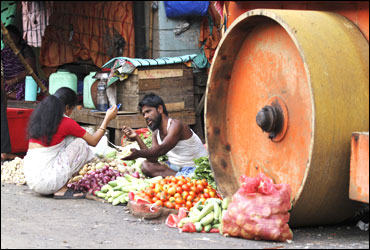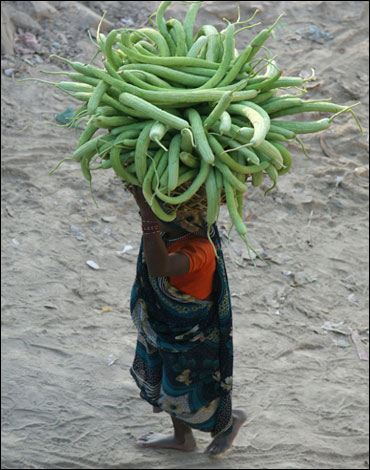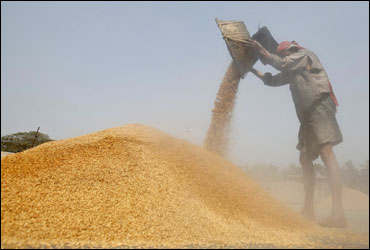Photographs: Rupak De Chowdhuri/Reuters
Food inflation fell to 8.06 per cent for the week ended May 21 on the back of cheaper pulses, wheat and some vegetables, with the latest numbers likely to be seen by the government as a silver lining after the slowdown in economic growth during the first quarter.
Food inflation, as measured by the Wholesale Price Index (WPI), stood at 8.55 per cent during the previous week. The rate of price rise of food items was as high as 21.15 per cent in the third week of May, 2010.
As per data released by government on Thursday, prices of pulses were down by 9.22 per cent year-on-year, while wheat became cheaper by 0.77 per cent.
This seems to be a reflection of the record production of wheat and pulses during the 2010-11 crop year (July-June).Food inflation falls to 8.06% for week ended May 21
Image: A woman carries cucumbers from her field to sell in the markets in Allahabad.Photographs: Jitendra Prakash/Reuters
During the week under review, prices of vegetables overall were down by 1.06 per cent on an annual basis, while potatoes became cheaper by 2.15 per cent.
However, prices of other food items became more expensive. Fruits were up by 30.51 per cent and onions by 12.32 per cent year-on-year.
Protein-based item also continued on their recent upward trend, with milk prices becoming dearer by 7.04 per cent and eggs, meat and fish becoming 5.50 per cent costlier.
Cereals became dearer by 4.78 per cent, with prices of rice going up by 2.51 per cent.
Overall, primary articles prices registered 10.87 per cent inflation during the week under review, compared to 11.60 per cent in the previous week.
Meanwhile, non-food primary articles inflation went down to 21.31 per cent for the week ended May 21 from 23.22 per cent in the previous week.
Food inflation falls to 8.06% for week ended May 21
Image: A labourer works at a rice mill on the outskirts of Agartala.Photographs: Jayanta Dey/Reuters
Fibres became dearer by 55.82 per cent and minerals by 11.78 per cent.
The recent hike in retail prices of petrol was also reflected in the data. Petrol was up 32.41 per cent year-on-year. Inflation in petrol had stood consistent at 21.81 per cent during the previous few weeks.
The government and Reserve Bank had said that in the months to come, inflationary pressure would be more from core (non-food) items on account of high global prices of commodities, particularly crude.
A rise in prices of food items was the main reason for inflationary pressure during 2010. Food inflation was in double digits for most of last year, before showing signs of moderation from March this year.
Food inflation falls to 8.06% for week ended May 21
Image: A vendor sits in front of sacks filled with potatoes at a wholesale vegetable market in Kolkata.Photographs: Rupak De Chowdhuri/Reuters
Food inflation fell to an 18-month low of 7.47 per cent in the first week of May, before rising again in the second week.
Headline inflation stood at 8.66 per cent in April. The RBI, in its monetary policy for 2011-12, had projected that overall inflation would average 9 per cent during the first half of this fiscal.
The latest drop in food inflation numbers comes in the wake of a slew of bad news for the economy. GDP growth of the country slowed to a five-quarter low of 7.8 per cent during the January-March quarter, while the six core industries registered meagre 5.2 per cent expansion in April.
Experts had blamed inflation and the resultant rate hikes by the RBI, which resulted in slowing down of investment, for the poor economic growth numbers.





article